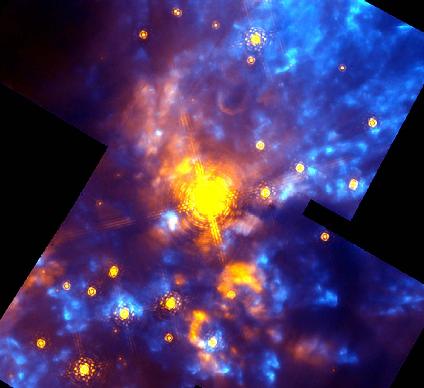Credit & Copyright: R. Thompson
(U. Arizona)
et al.,
NASA
Explanation:
Newborn stars lie at
at the heart
of the
the Orion Nebula,
hidden from view by the dust and gas of the giant Orion
Molecular Cloud number 1
(OMC-1).
Sensitive to invisible
infrared
wavelengths, Hubble's NICMOS camera
can explore the
interior of OMC-1 detecting the infrared radiation from
infant star clusters and
the interstellar dust and atoms energized by their intense starlight.
In this false color picture,
stars and the glowing dust clouds which also scatter the starlight appear
yellowish orange while emission from hydrogen gas is blue.
The dramatic image reveals a wealth of details, including
many filaments and arcs of gas and dust
-- evidence of violent motions stirred-up by the emerging stars.
The bright object near the center is the massive young star "BN"
(named for its discoverers Becklin and Neugebauer).
The pattern of speckles and
ripples surrounding BN and other bright stars are image artifacts.
1999 2000 2001 2002 2003 2004 2005 2006 2007 2008 2009 2010 2011 2012 2013 2014 2015 2016 2017 2018 2019 2020 2021 2022 2023 2024 2025 |
Yanvar' Fevral' Mart Aprel' Mai Iyun' Iyul' Avgust Sentyabr' Oktyabr' Noyabr' Dekabr' |
NASA Web Site Statements, Warnings, and Disclaimers
NASA Official: Jay Norris. Specific rights apply.
A service of: LHEA at NASA / GSFC
& Michigan Tech. U.
|
Publikacii s klyuchevymi slovami:
Orion - infrared - molecular cloud - Orion Nebula - star formation - Tumannost' Oriona - molodye zvezdy - zvezdoobrazovanie - infrakrasnoe izluchenie
Publikacii so slovami: Orion - infrared - molecular cloud - Orion Nebula - star formation - Tumannost' Oriona - molodye zvezdy - zvezdoobrazovanie - infrakrasnoe izluchenie | |
Sm. takzhe:
Vse publikacii na tu zhe temu >> | |
